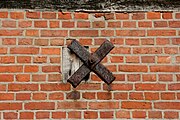Anchor plate
This article needs additional citations for verification. (October 2010) |

An anchor plate or wall washer is a large plate or washer connected to a tie rod or bolt. Anchor plates are used on exterior walls of masonry buildings, for structural reinforcement. Being visible, many anchor plates are made in a style that is decorative.[1]
One popular style is the star anchor — an anchor plate cast or wrought in the shape of a five-pointed star. Other names and styles of anchor plate include earthquake washer, triangular washer, S-iron, and T-head.[1] In the United Kingdom, pattress plate is the term for circular restraints,[2] tie bar being an alternate term for rectangular restraints.
Anchor plates are made of cast iron, sometimes wrought iron or steel, and are often used on brick or other masonry-based buildings. They are easy to find in cities with substantial legacies of 18th- and 19th-century brick construction, such as New York, Philadelphia, St. Louis, and Charleston, South Carolina, and in older earthquake prone cities such as San Francisco, as well as earlier examples in Gamla Stan, the Old Town in Stockholm. The tie-rod-and-plate assembly braces the masonry wall against lateral bowing.
History of use
Gallery
-
On a building in Petaluma, California
-
Tie rods and anchor plates in the ruins of Coventry Cathedral
-
Anchor plate on a church in North Rhine-Westphalia
-
X-shaped wall anchor in Lower Saxony
-
Bar-style wall anchor in Florence
-
A rotated star-shaped anchor plate in Connecticut
-
A star-shaped anchor plate in Soulard, St. Louis
-
An anchor plate in the cloister of the Church of St. Trophime, Arles (France)
See also
- Barnstar, a purely decorative device
- Tie (cavity wall), used internally within cavity walls
References
- ^ a b Bucher, Ward (1996). Dictionary of Building Preservation. Preservation Press. p. 576.
- ^ Pattress plate example stainless-uk.co.uk








